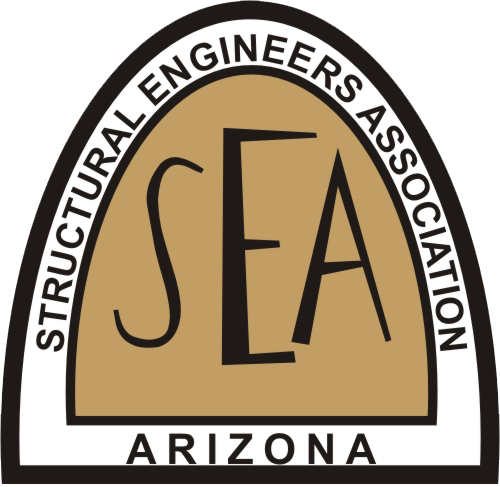January 3rd, 2017
Dear Structural Engineers Association of Arizona,
The Structural Engineers Association of Arizona Code Committee meets on an “as needed” basis and is open to any SEAoA member and any member of the public. The meeting’s time, place, and agenda are on the SEAoA website and also emailed to all SEAoA members at least two weeks prior to the meeting.
The next meeting of the Structural Engineers Association of Arizona Code Committee is on Tuesday, January 22nd, 2017 at 3:00 p.m. at Caruso Turley Scott Inc. office at 1215 W. Rio Salado Parkway, Suite 200, Tempe, AZ 85281.
The last Code Committee meeting occurred on September 1st, 2016. The agenda and meeting minutes from that meeting are below:
Structural Engineers Association of Arizona
Code Committee Meeting
Thursday September 1, 2016| 3:00-5:00pm | CTS office, Tempe
Call-In Information: 641-715-0700 Access Code# 622313 (Leader PIN 1989)
AGENDA
1. Foundation support works letter, ICC ESR-3074 and problems faced by contractors for Helical Pile system for residential projects
ACTION TAKEN:
Bob Brown explained what the intent was for this topic and passed out a rough draft of a recommended procedure to be followed by jurisdictions for the installation of helical piers. The Code Committee will review the rough draft and be ready to discuss this item at the next Code Committee meeting.
2. The Metal Building Manufacturer’s Association (MBMA) has, according to an unsubstantiated report, recently requested its members (Butler, Star, Mettalic, Varco Pruden, etc.) to no longer show the reaction at each column location for the worst-case load combination. This is something structural engineers have requested (even specified on their drawings) and been able to get in the past. Now the MBMA appears to want to only list the reactions from each primary load and leave it to structural design engineer to calculate the worst-case load combination. This wouldn’t be such a problem except for that there may be 90-plus load cases. Even with spreadsheet, this is time consuming and error-prone for us. The MBMA members already have it built into their analysis software and can easily show these worst-case reactions.
ACTION TAKEN:
David Gibbons has worked with Lee Shoemaker of the MBMA to come up with how the loads will be shown and the maximums will be listed as requested by the SEAoA.
3. Start the state snow load discussion in order to respond to ASCE 07. ASCE 7 is asking for input from us regarding the snow loads in AZ.
ACTION TAKEN:
Scott Freestone has not heard back from the ASCE 7 regarding using the revised Arizona snow load data that Scott Freestone has researched and documented.
4. Finalize the Six year code cycle-IBC letter. A six year code cycle will, in our opinion, reduce burden of all practicing structural engineers to buy and learn the frequent 3 year IBC code cycle. The SEAoA Code Committee can form a position letter and request the SEAOA board to circulate the letter around to all the municipalities as the SEAOA position on code adoption. This will educate the municipalities on pitfalls and problems with frequent code adaptations. Some municipalities have followed the City of Phoenix’s 6 year adoption period. We request that SEAOA also send this to other member SEA’s around country to circulate such letters in their states.
ACTION TAKEN:
The letter stating the SEAoA position on the 6 year Code Cycle is now complete and will be sent out in early 2017. The intent is to send this position again to all the building officials in Arizona and all the SEA State Organizations.
5. Continue to review the City of Phoenix SSI certification program
ACTION TAKEN:
No new activity on this item.
6. Simpson Strong-Tie has a product called ‘Heli-Tie’ that requires is-site testing of the anchor pullout. It is most times hard to find equipment to do the test and is also expensive to do the testing. Can Simpson address this ?
ACTION TAKEN:
Tim Smith of Simpson Strong Tie (SST) explained the current method of how the inspection process works for the Heli-Tie product. There was a consensus that the methods currently used by SST were as good as they could be and no additional information is needed by SEAoA.
7. Regarding the ICC report ESR 3403, Simpson Strong-Tie Composite (Carbon Fiber) strengthening system, in regards to section 4.2, approved application is questionable in that how are these approved applicators determined ? Is it done at city or state level or by ICC ?
ACTION TAKEN:
Tim Smith of SST explained the method of training necessary to become a certified installer. There was a consensus that the methods currently used by SST were as good as they could be and no additional information is needed by SEAoA.
8. Approved steel fabrication shops. In some projects (mainly small) it is seen that the fabrication work is done by some fabrication shop, which may not carry the AISC certifications or have proper license. Should SEAOA have any input into shop certification?
ACTION TAKEN:
This item is continued to the next Code Committee meeting.
Please contact our office with any questions or comments at (480) 774-1700.
Respectfully submitted,
Paul G. Scott, PE, SE
CARUSO TURLEY SCOTT
Partner
T: (480) 774-1776 Direct
E: pscott@ctsaz.com
